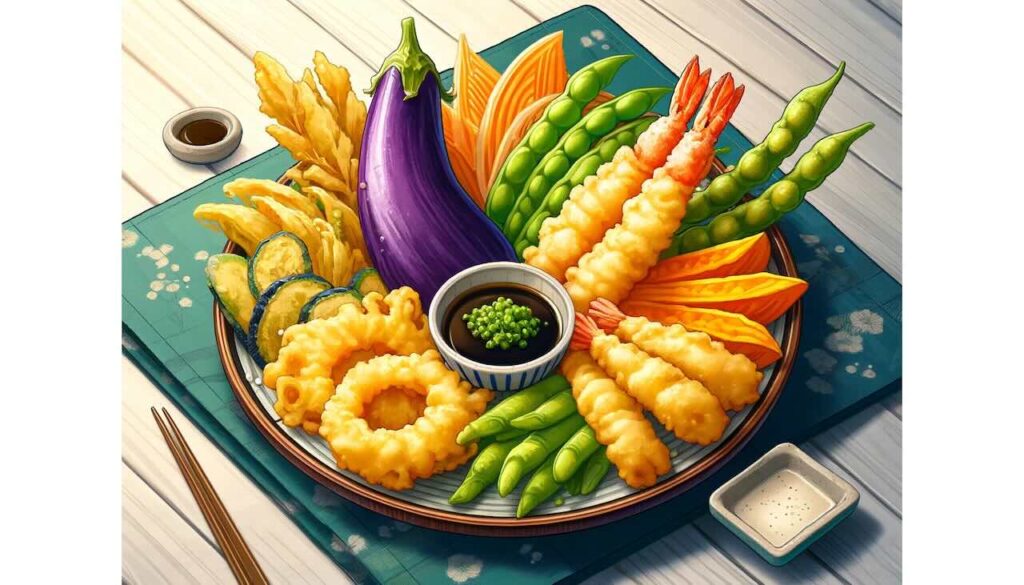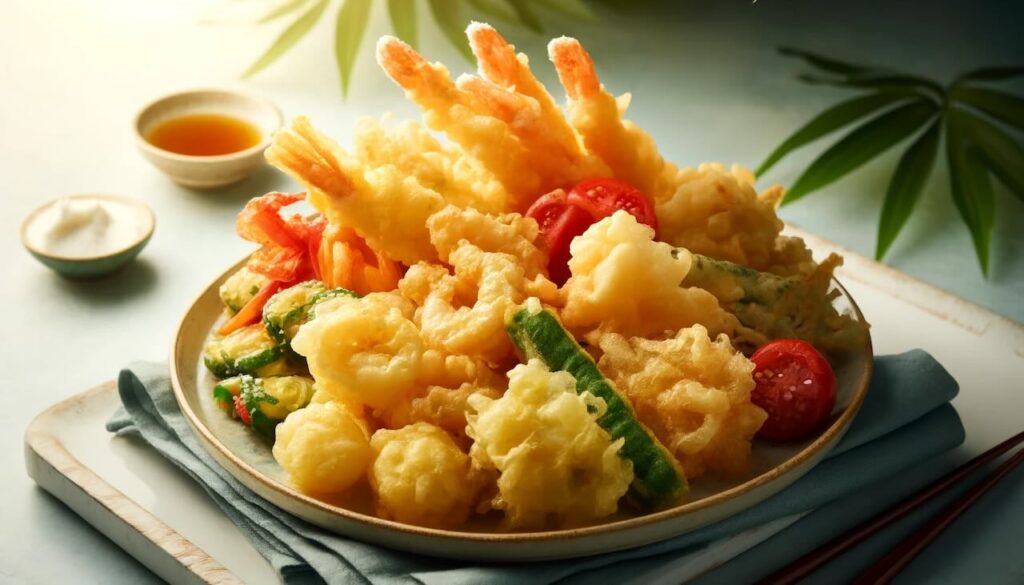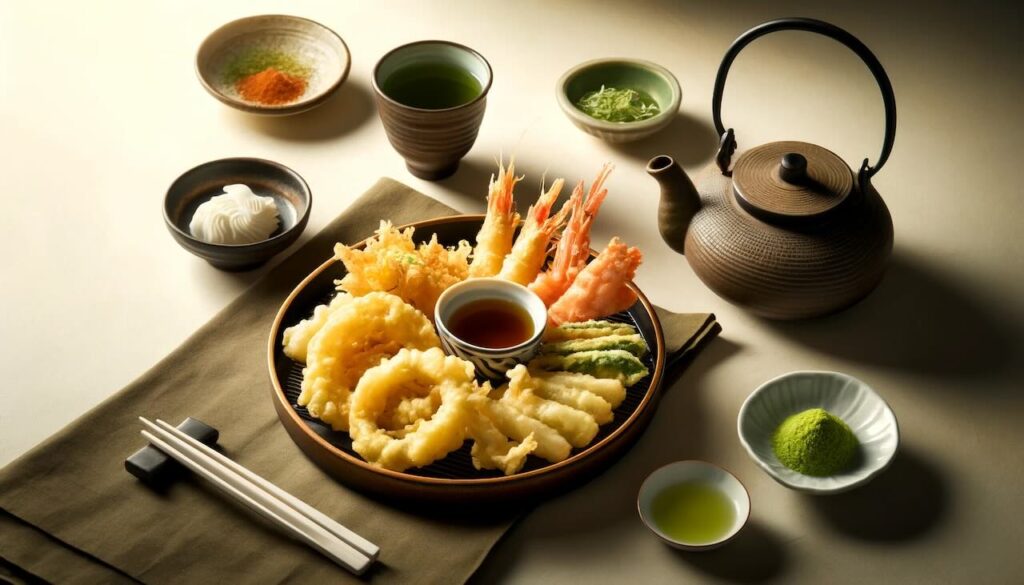Tempura may be one of Japan’s most beloved dishes, but as with many fried foods, it often raises questions about its health effects. Is tempura simply indulgent comfort food, or can it be part of a balanced Japanese diet? The answer — like much in Japanese food culture — lies in balance, quality, and moderation.
In this article, we’ll explore the nutritional aspects of tempura, its potential health effects, and practical tips for enjoying it mindfully while respecting the traditions of Japanese cuisine.
For a full exploration of tempura’s history, ingredients, etiquette, and cultural significance, visit:
👉 The Complete Guide to Tempura: Japan’s Artful Fried Delight
Nutritional Value of Tempura: More Than Just Frying
Tempura’s nutritional profile depends greatly on the ingredients used:
- Vegetables: Sweet potato, kabocha, lotus root, eggplant, and others contribute vitamins, fiber, potassium, and antioxidants.
- Seafood: Shrimp, squid, scallops, and conger eel offer high-quality protein, omega-3 fatty acids, and essential minerals.
- Batter: Made from flour, cold water, and occasionally egg, the batter itself is thin and light when properly prepared.
Interestingly, quick deep-frying at high temperatures helps seal moisture inside the ingredients and limits oil absorption — especially compared to Western frying techniques that use thicker batters and longer cooking times.
However, tempura still contains added calories from frying. A typical serving (6–8 pieces) may provide:
- Calories: ~400–600 kcal
- Fat: 20–30g
- Protein: ~15–20g (especially seafood-based)
- Carbohydrates: ~30–50g (batter and vegetables combined)
Tempura’s true nutritional strength lies in its ingredient diversity, seasonal freshness, and small portion sizes, hallmarks of the broader Japanese approach to eating.
To discover the best ingredients used in tempura, visit:
👉 The Essential Ingredients of Tempura: From Tradition to Creative Variations
Health Effects: Balancing Benefits and Risks
The Positives
- High-quality oils: Japanese tempura chefs often use fresh vegetable oils such as sesame or canola, rich in unsaturated fats.
- Quick frying technique: High-temperature frying (170–180°C / 338–356°F) minimizes oil absorption when done correctly.
- Micronutrients: Vegetables retain much of their nutritional value due to the short cooking time.
The Concerns
- Calorie density: Frequent large portions can contribute to weight gain if not balanced within the broader diet.
- Oxidized oils: Overheated or reused oil may introduce harmful compounds if not carefully managed.
- Gluten content: Standard tempura batter contains wheat flour; those with gluten sensitivities may need alternatives.
Japanese dietary philosophy, rooted in moderation (hōshoku) and seasonal mindfulness (shun), naturally promotes portion control and variety, keeping fried foods like tempura from dominating the meal.
How to Enjoy Tempura Health-Consciously
Japanese people have long developed simple, effective habits to make tempura part of a balanced lifestyle:
1. Use Fresh Oil
Restaurants and skilled home cooks regularly change oil to maintain flavor and avoid degraded fats.
2. Control Temperature
Keeping oil at the ideal range (170–180°C) ensures crisp batter while minimizing oil absorption.
3. Portion Moderation
Tempura is rarely eaten in large quantities in Japan. A few carefully selected seasonal pieces are often paired with rice, miso soup, pickles, and vegetables to create a complete, balanced meal.
4. Favor Vegetable-Based Tempura
Vegetable tempura offers more fiber, vitamins, and lower calorie density than seafood-heavy platters.
5. Pair with Traditional Accompaniments
Eating tempura alongside miso soup, seaweed salads, or lightly dressed greens adds both nutrition and variety.
For etiquette tips on how to best enjoy tempura at the table, visit:
👉 Mastering the Art of Eating Tempura: Etiquette and Tips for Enjoying Japan’s Favorite Fried Dish
Tempura Within Japanese Food Culture: Balance Above All
The question of tempura’s healthfulness reflects broader Japanese cultural values: rather than labeling foods as “good” or “bad,” emphasis is placed on balance, portion, seasonality, and appreciation of craft.
Tempura is often enjoyed in small servings as part of a multi-course meal (kaiseki) or as a specialty at dedicated tempura-ya restaurants where each piece is served individually, allowing for portion control and full appreciation of each ingredient.
Conclusion
Tempura demonstrates that even fried foods, when prepared thoughtfully, can have a place within a health-conscious diet. By focusing on fresh ingredients, correct cooking techniques, and mindful portion sizes, you can enjoy this celebrated Japanese art form without compromising your health.
Tempura is not simply food — it’s a reflection of Japan’s refined culinary values: simplicity, craftsmanship, seasonality, and respect for nature’s bounty.


